Work and Organizations: A Case Study on Attitudes and Job Satisfaction
VerifiedAdded on 2023/06/12
|6
|1409
|267
Case Study
AI Summary
This case study explores the multifaceted nature of job satisfaction, highlighting how individual perceptions, leadership, and organizational culture influence employee attitudes and performance. It examines scenarios where individuals find satisfaction in demanding jobs with long hours due to factors like financial rewards and effective leadership. The study further discusses the impact of job satisfaction on employee behavior, citizenship, and turnover rates, emphasizing the importance of a positive work environment. It also touches upon how the perception of job scarcity can contribute to increased job satisfaction. The case study concludes that while individual perceptions of a satisfying job vary, the realities of employment often lead to adaptation and a redefined sense of satisfaction, driven by both personal aspirations and external pressures. Desklib provides access to similar case studies and solved assignments for students.
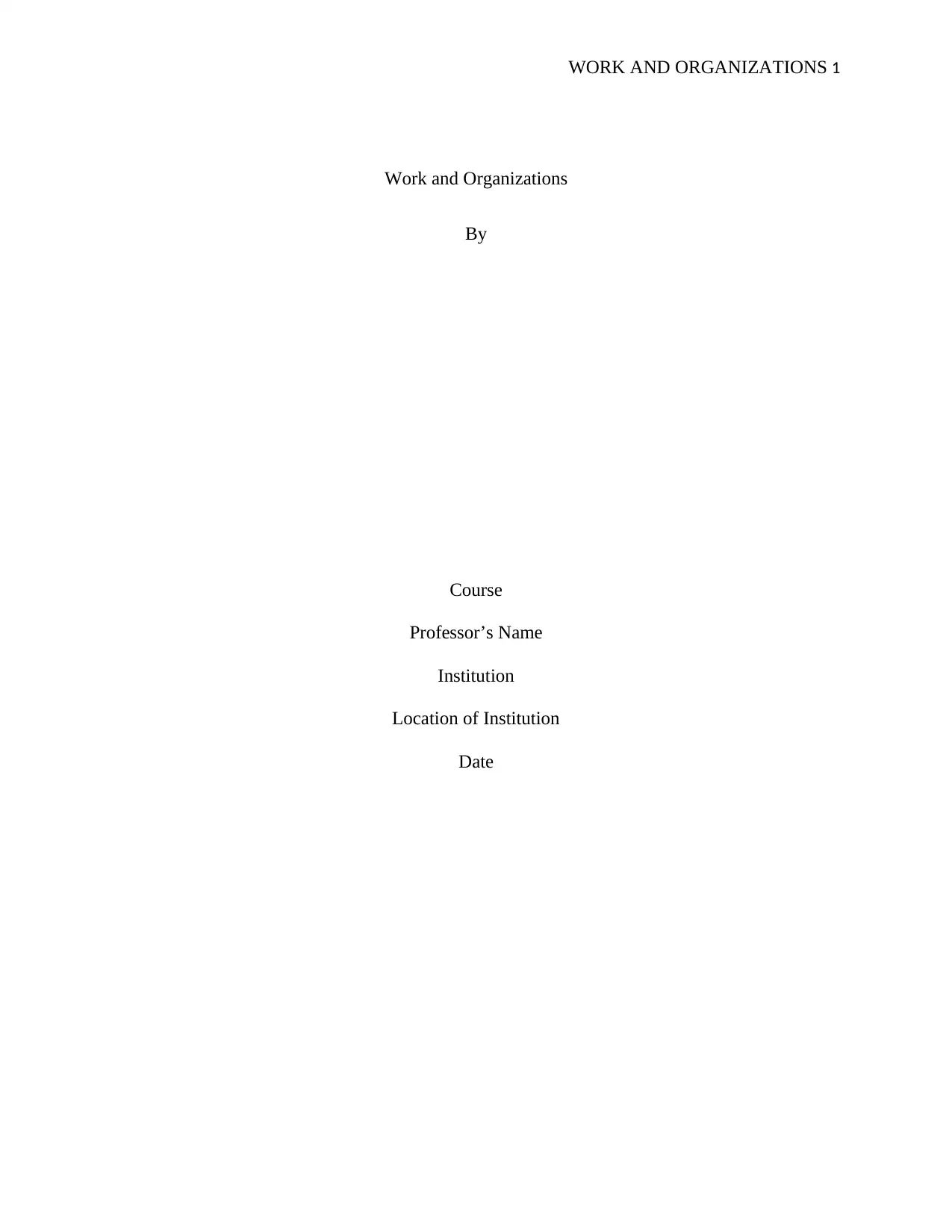
WORK AND ORGANIZATIONS 1
Work and Organizations
By
Course
Professor’s Name
Institution
Location of Institution
Date
Work and Organizations
By
Course
Professor’s Name
Institution
Location of Institution
Date
Paraphrase This Document
Need a fresh take? Get an instant paraphrase of this document with our AI Paraphraser
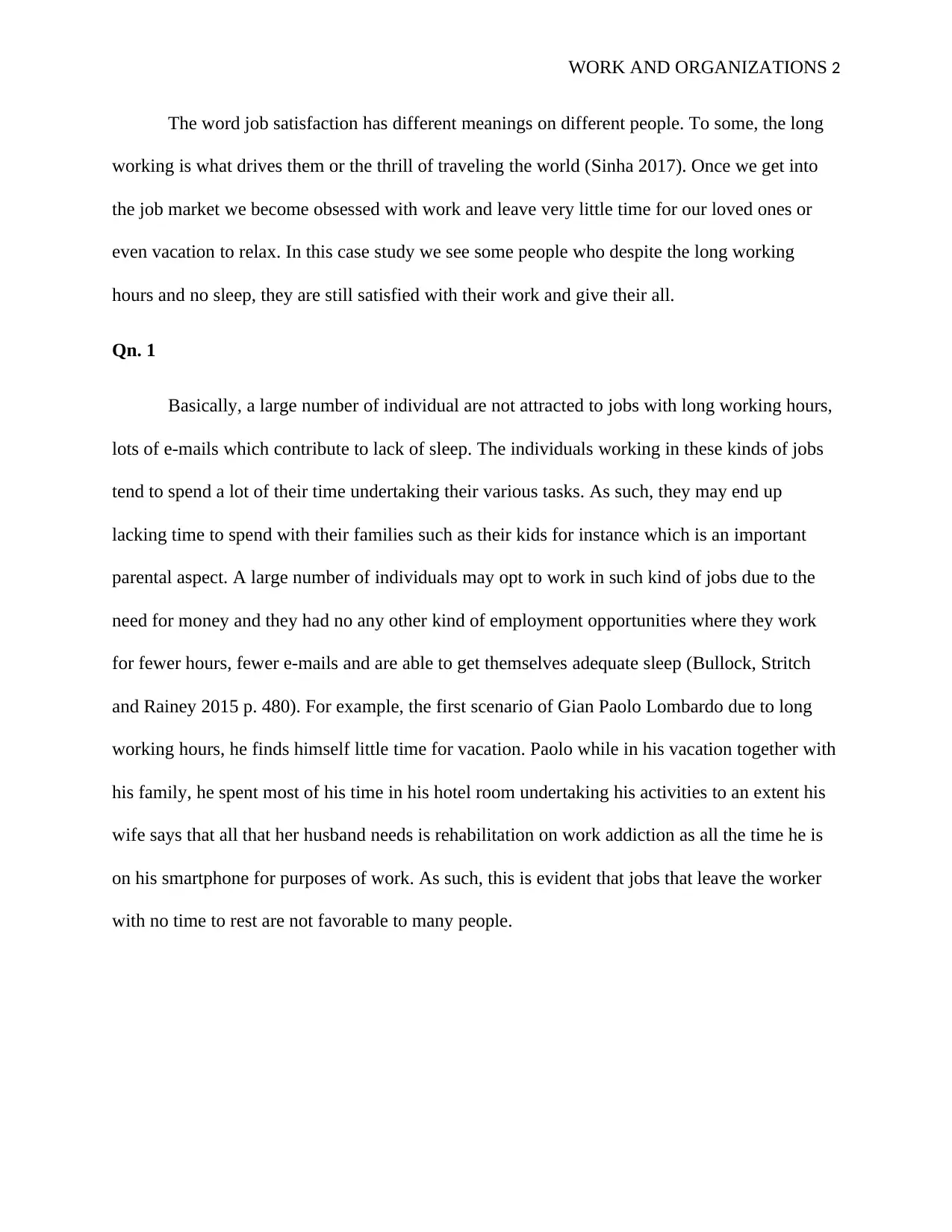
WORK AND ORGANIZATIONS 2
The word job satisfaction has different meanings on different people. To some, the long
working is what drives them or the thrill of traveling the world (Sinha 2017). Once we get into
the job market we become obsessed with work and leave very little time for our loved ones or
even vacation to relax. In this case study we see some people who despite the long working
hours and no sleep, they are still satisfied with their work and give their all.
Qn. 1
Basically, a large number of individual are not attracted to jobs with long working hours,
lots of e-mails which contribute to lack of sleep. The individuals working in these kinds of jobs
tend to spend a lot of their time undertaking their various tasks. As such, they may end up
lacking time to spend with their families such as their kids for instance which is an important
parental aspect. A large number of individuals may opt to work in such kind of jobs due to the
need for money and they had no any other kind of employment opportunities where they work
for fewer hours, fewer e-mails and are able to get themselves adequate sleep (Bullock, Stritch
and Rainey 2015 p. 480). For example, the first scenario of Gian Paolo Lombardo due to long
working hours, he finds himself little time for vacation. Paolo while in his vacation together with
his family, he spent most of his time in his hotel room undertaking his activities to an extent his
wife says that all that her husband needs is rehabilitation on work addiction as all the time he is
on his smartphone for purposes of work. As such, this is evident that jobs that leave the worker
with no time to rest are not favorable to many people.
The word job satisfaction has different meanings on different people. To some, the long
working is what drives them or the thrill of traveling the world (Sinha 2017). Once we get into
the job market we become obsessed with work and leave very little time for our loved ones or
even vacation to relax. In this case study we see some people who despite the long working
hours and no sleep, they are still satisfied with their work and give their all.
Qn. 1
Basically, a large number of individual are not attracted to jobs with long working hours,
lots of e-mails which contribute to lack of sleep. The individuals working in these kinds of jobs
tend to spend a lot of their time undertaking their various tasks. As such, they may end up
lacking time to spend with their families such as their kids for instance which is an important
parental aspect. A large number of individuals may opt to work in such kind of jobs due to the
need for money and they had no any other kind of employment opportunities where they work
for fewer hours, fewer e-mails and are able to get themselves adequate sleep (Bullock, Stritch
and Rainey 2015 p. 480). For example, the first scenario of Gian Paolo Lombardo due to long
working hours, he finds himself little time for vacation. Paolo while in his vacation together with
his family, he spent most of his time in his hotel room undertaking his activities to an extent his
wife says that all that her husband needs is rehabilitation on work addiction as all the time he is
on his smartphone for purposes of work. As such, this is evident that jobs that leave the worker
with no time to rest are not favorable to many people.
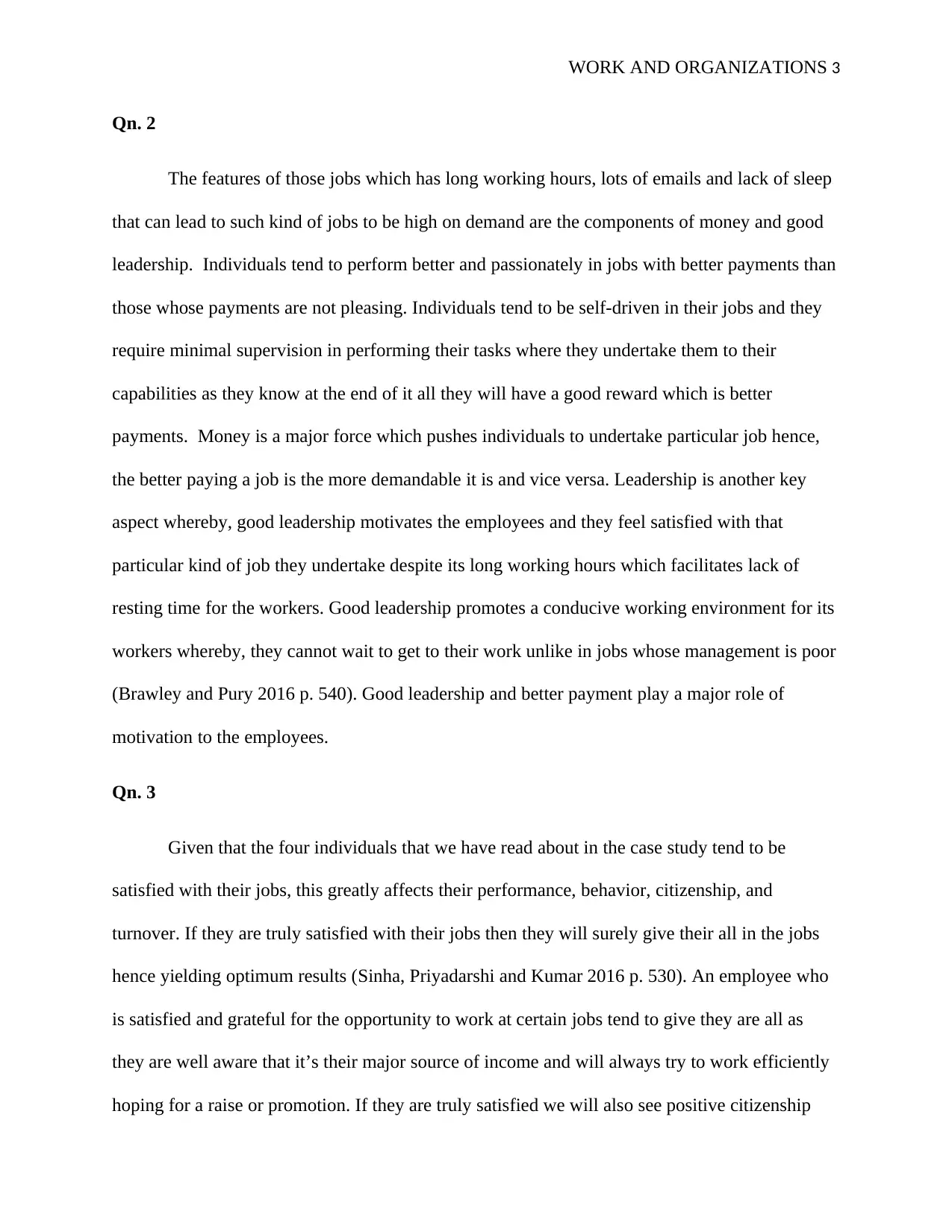
WORK AND ORGANIZATIONS 3
Qn. 2
The features of those jobs which has long working hours, lots of emails and lack of sleep
that can lead to such kind of jobs to be high on demand are the components of money and good
leadership. Individuals tend to perform better and passionately in jobs with better payments than
those whose payments are not pleasing. Individuals tend to be self-driven in their jobs and they
require minimal supervision in performing their tasks where they undertake them to their
capabilities as they know at the end of it all they will have a good reward which is better
payments. Money is a major force which pushes individuals to undertake particular job hence,
the better paying a job is the more demandable it is and vice versa. Leadership is another key
aspect whereby, good leadership motivates the employees and they feel satisfied with that
particular kind of job they undertake despite its long working hours which facilitates lack of
resting time for the workers. Good leadership promotes a conducive working environment for its
workers whereby, they cannot wait to get to their work unlike in jobs whose management is poor
(Brawley and Pury 2016 p. 540). Good leadership and better payment play a major role of
motivation to the employees.
Qn. 3
Given that the four individuals that we have read about in the case study tend to be
satisfied with their jobs, this greatly affects their performance, behavior, citizenship, and
turnover. If they are truly satisfied with their jobs then they will surely give their all in the jobs
hence yielding optimum results (Sinha, Priyadarshi and Kumar 2016 p. 530). An employee who
is satisfied and grateful for the opportunity to work at certain jobs tend to give they are all as
they are well aware that it’s their major source of income and will always try to work efficiently
hoping for a raise or promotion. If they are truly satisfied we will also see positive citizenship
Qn. 2
The features of those jobs which has long working hours, lots of emails and lack of sleep
that can lead to such kind of jobs to be high on demand are the components of money and good
leadership. Individuals tend to perform better and passionately in jobs with better payments than
those whose payments are not pleasing. Individuals tend to be self-driven in their jobs and they
require minimal supervision in performing their tasks where they undertake them to their
capabilities as they know at the end of it all they will have a good reward which is better
payments. Money is a major force which pushes individuals to undertake particular job hence,
the better paying a job is the more demandable it is and vice versa. Leadership is another key
aspect whereby, good leadership motivates the employees and they feel satisfied with that
particular kind of job they undertake despite its long working hours which facilitates lack of
resting time for the workers. Good leadership promotes a conducive working environment for its
workers whereby, they cannot wait to get to their work unlike in jobs whose management is poor
(Brawley and Pury 2016 p. 540). Good leadership and better payment play a major role of
motivation to the employees.
Qn. 3
Given that the four individuals that we have read about in the case study tend to be
satisfied with their jobs, this greatly affects their performance, behavior, citizenship, and
turnover. If they are truly satisfied with their jobs then they will surely give their all in the jobs
hence yielding optimum results (Sinha, Priyadarshi and Kumar 2016 p. 530). An employee who
is satisfied and grateful for the opportunity to work at certain jobs tend to give they are all as
they are well aware that it’s their major source of income and will always try to work efficiently
hoping for a raise or promotion. If they are truly satisfied we will also see positive citizenship
⊘ This is a preview!⊘
Do you want full access?
Subscribe today to unlock all pages.

Trusted by 1+ million students worldwide
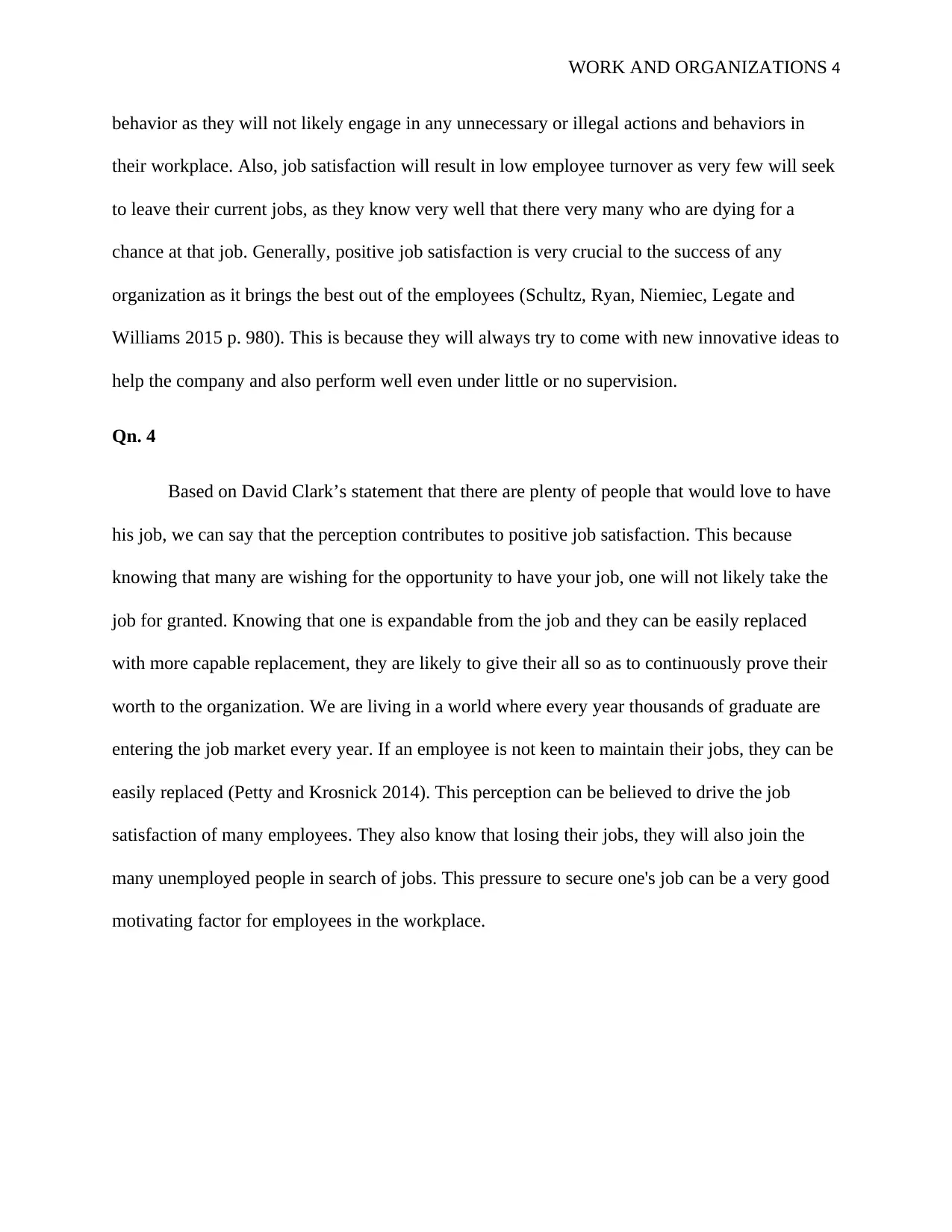
WORK AND ORGANIZATIONS 4
behavior as they will not likely engage in any unnecessary or illegal actions and behaviors in
their workplace. Also, job satisfaction will result in low employee turnover as very few will seek
to leave their current jobs, as they know very well that there very many who are dying for a
chance at that job. Generally, positive job satisfaction is very crucial to the success of any
organization as it brings the best out of the employees (Schultz, Ryan, Niemiec, Legate and
Williams 2015 p. 980). This is because they will always try to come with new innovative ideas to
help the company and also perform well even under little or no supervision.
Qn. 4
Based on David Clark’s statement that there are plenty of people that would love to have
his job, we can say that the perception contributes to positive job satisfaction. This because
knowing that many are wishing for the opportunity to have your job, one will not likely take the
job for granted. Knowing that one is expandable from the job and they can be easily replaced
with more capable replacement, they are likely to give their all so as to continuously prove their
worth to the organization. We are living in a world where every year thousands of graduate are
entering the job market every year. If an employee is not keen to maintain their jobs, they can be
easily replaced (Petty and Krosnick 2014). This perception can be believed to drive the job
satisfaction of many employees. They also know that losing their jobs, they will also join the
many unemployed people in search of jobs. This pressure to secure one's job can be a very good
motivating factor for employees in the workplace.
behavior as they will not likely engage in any unnecessary or illegal actions and behaviors in
their workplace. Also, job satisfaction will result in low employee turnover as very few will seek
to leave their current jobs, as they know very well that there very many who are dying for a
chance at that job. Generally, positive job satisfaction is very crucial to the success of any
organization as it brings the best out of the employees (Schultz, Ryan, Niemiec, Legate and
Williams 2015 p. 980). This is because they will always try to come with new innovative ideas to
help the company and also perform well even under little or no supervision.
Qn. 4
Based on David Clark’s statement that there are plenty of people that would love to have
his job, we can say that the perception contributes to positive job satisfaction. This because
knowing that many are wishing for the opportunity to have your job, one will not likely take the
job for granted. Knowing that one is expandable from the job and they can be easily replaced
with more capable replacement, they are likely to give their all so as to continuously prove their
worth to the organization. We are living in a world where every year thousands of graduate are
entering the job market every year. If an employee is not keen to maintain their jobs, they can be
easily replaced (Petty and Krosnick 2014). This perception can be believed to drive the job
satisfaction of many employees. They also know that losing their jobs, they will also join the
many unemployed people in search of jobs. This pressure to secure one's job can be a very good
motivating factor for employees in the workplace.
Paraphrase This Document
Need a fresh take? Get an instant paraphrase of this document with our AI Paraphraser
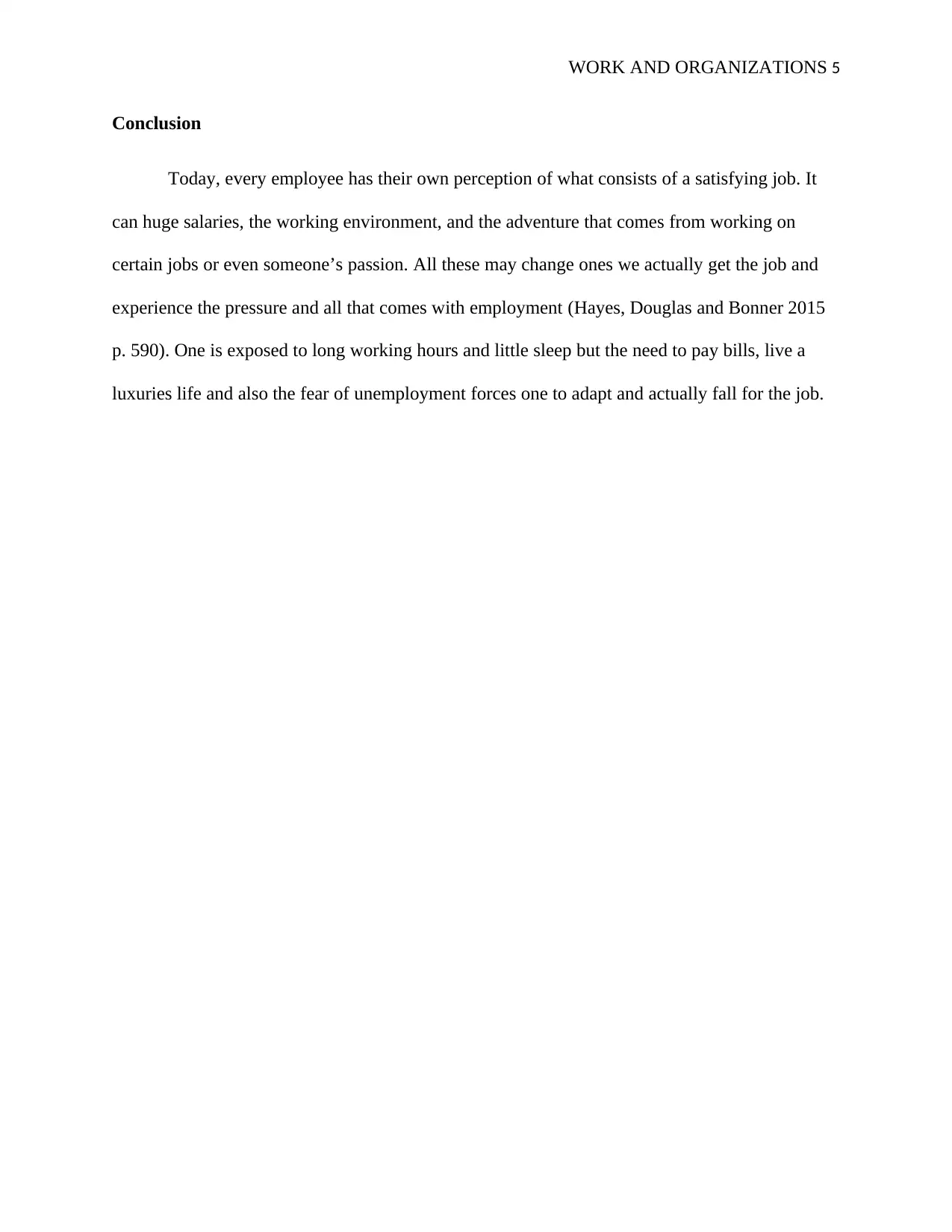
WORK AND ORGANIZATIONS 5
Conclusion
Today, every employee has their own perception of what consists of a satisfying job. It
can huge salaries, the working environment, and the adventure that comes from working on
certain jobs or even someone’s passion. All these may change ones we actually get the job and
experience the pressure and all that comes with employment (Hayes, Douglas and Bonner 2015
p. 590). One is exposed to long working hours and little sleep but the need to pay bills, live a
luxuries life and also the fear of unemployment forces one to adapt and actually fall for the job.
Conclusion
Today, every employee has their own perception of what consists of a satisfying job. It
can huge salaries, the working environment, and the adventure that comes from working on
certain jobs or even someone’s passion. All these may change ones we actually get the job and
experience the pressure and all that comes with employment (Hayes, Douglas and Bonner 2015
p. 590). One is exposed to long working hours and little sleep but the need to pay bills, live a
luxuries life and also the fear of unemployment forces one to adapt and actually fall for the job.
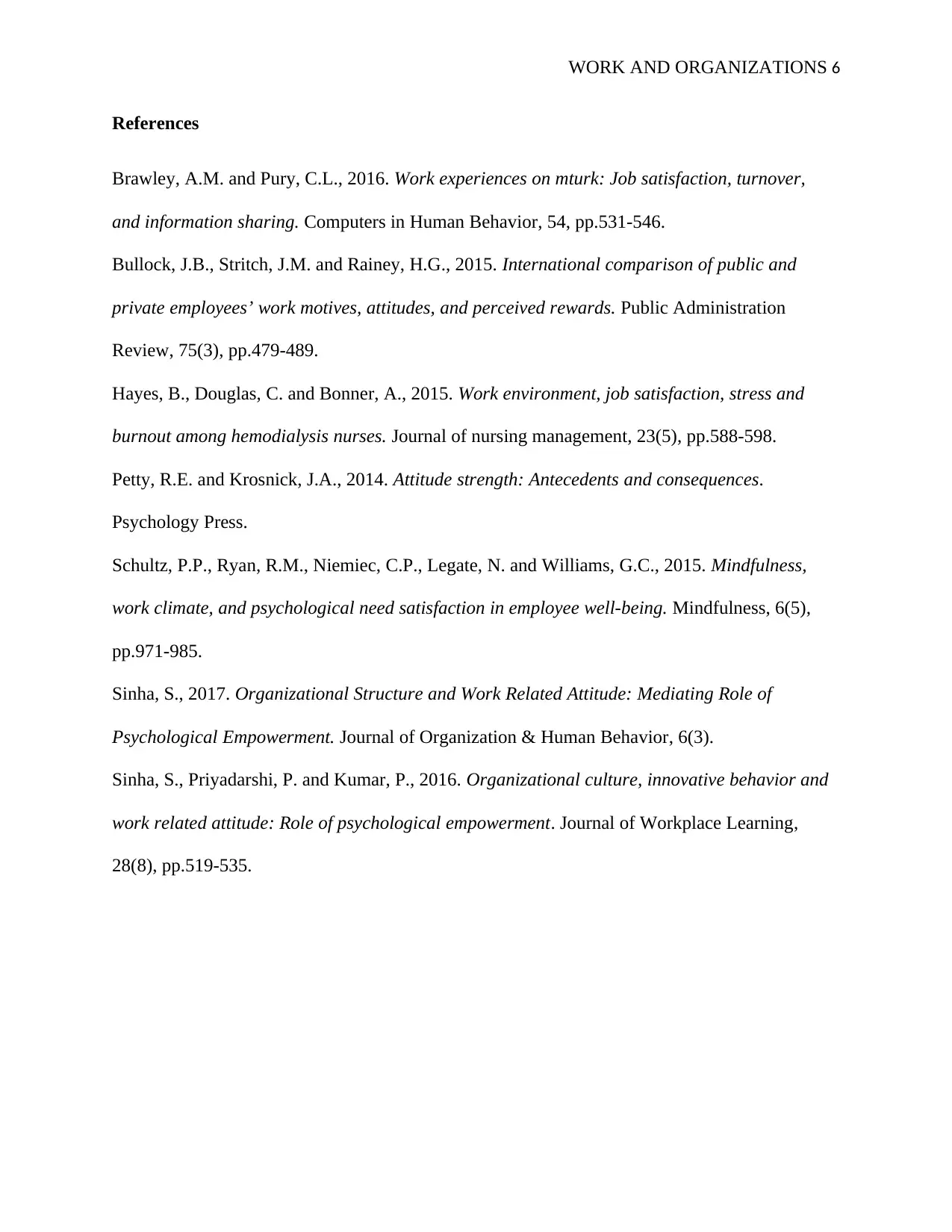
WORK AND ORGANIZATIONS 6
References
Brawley, A.M. and Pury, C.L., 2016. Work experiences on mturk: Job satisfaction, turnover,
and information sharing. Computers in Human Behavior, 54, pp.531-546.
Bullock, J.B., Stritch, J.M. and Rainey, H.G., 2015. International comparison of public and
private employees’ work motives, attitudes, and perceived rewards. Public Administration
Review, 75(3), pp.479-489.
Hayes, B., Douglas, C. and Bonner, A., 2015. Work environment, job satisfaction, stress and
burnout among hemodialysis nurses. Journal of nursing management, 23(5), pp.588-598.
Petty, R.E. and Krosnick, J.A., 2014. Attitude strength: Antecedents and consequences.
Psychology Press.
Schultz, P.P., Ryan, R.M., Niemiec, C.P., Legate, N. and Williams, G.C., 2015. Mindfulness,
work climate, and psychological need satisfaction in employee well-being. Mindfulness, 6(5),
pp.971-985.
Sinha, S., 2017. Organizational Structure and Work Related Attitude: Mediating Role of
Psychological Empowerment. Journal of Organization & Human Behavior, 6(3).
Sinha, S., Priyadarshi, P. and Kumar, P., 2016. Organizational culture, innovative behavior and
work related attitude: Role of psychological empowerment. Journal of Workplace Learning,
28(8), pp.519-535.
References
Brawley, A.M. and Pury, C.L., 2016. Work experiences on mturk: Job satisfaction, turnover,
and information sharing. Computers in Human Behavior, 54, pp.531-546.
Bullock, J.B., Stritch, J.M. and Rainey, H.G., 2015. International comparison of public and
private employees’ work motives, attitudes, and perceived rewards. Public Administration
Review, 75(3), pp.479-489.
Hayes, B., Douglas, C. and Bonner, A., 2015. Work environment, job satisfaction, stress and
burnout among hemodialysis nurses. Journal of nursing management, 23(5), pp.588-598.
Petty, R.E. and Krosnick, J.A., 2014. Attitude strength: Antecedents and consequences.
Psychology Press.
Schultz, P.P., Ryan, R.M., Niemiec, C.P., Legate, N. and Williams, G.C., 2015. Mindfulness,
work climate, and psychological need satisfaction in employee well-being. Mindfulness, 6(5),
pp.971-985.
Sinha, S., 2017. Organizational Structure and Work Related Attitude: Mediating Role of
Psychological Empowerment. Journal of Organization & Human Behavior, 6(3).
Sinha, S., Priyadarshi, P. and Kumar, P., 2016. Organizational culture, innovative behavior and
work related attitude: Role of psychological empowerment. Journal of Workplace Learning,
28(8), pp.519-535.
⊘ This is a preview!⊘
Do you want full access?
Subscribe today to unlock all pages.

Trusted by 1+ million students worldwide
1 out of 6
Related Documents
Your All-in-One AI-Powered Toolkit for Academic Success.
+13062052269
info@desklib.com
Available 24*7 on WhatsApp / Email
![[object Object]](/_next/static/media/star-bottom.7253800d.svg)
Unlock your academic potential
Copyright © 2020–2025 A2Z Services. All Rights Reserved. Developed and managed by ZUCOL.





